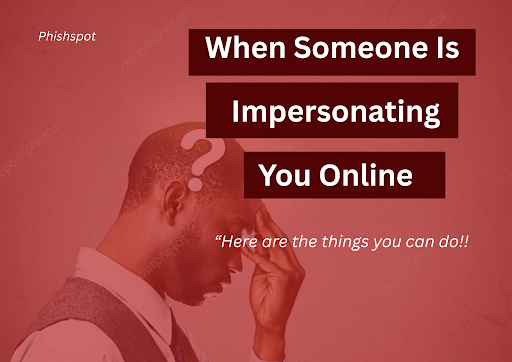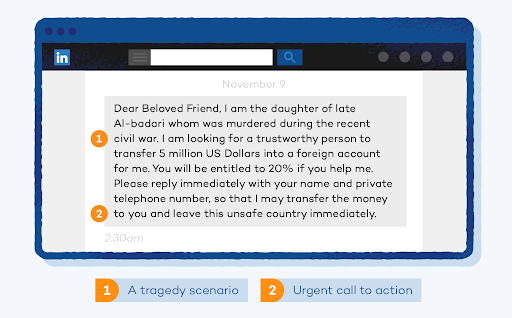← Back to blogs




What to Do When Someone Impersonates You Online | PhishSpot
Discover how to handle online impersonation fast. Learn how to trace fake profiles, report impersonators, and protect your digital identity with AI tools.
July 28, 2025 • 5 min read • Janet Oduyomi

Introduction
Imagine waking up to find someone using your photos, name, and personal information pretending to be you online. This is known as “online impersonation”, and it’s becoming more common on platforms like Facebook, Instagram, and TikTok.
From fake social media accounts to phishing DMs and catfishing scams, knowing “what to do when someone is impersonating you online” is essential to protect your digital identity.
According to the FTC's Consumer Sentinel Report, over 1.1 million identity theft reports were filed in 2023, with a sharp increase in cases of online impersonation on platforms like Facebook, Instagram, TikTok, and LinkedIn.
If you're a content creator, business owner, or just a regular user, knowing what to do when someone is impersonating you online can save you from emotional, financial, and reputational damage.
In this guide, we will walk you through:
- What impersonation is
- Why it happens
- How to identify it
- Steps to stop it
- How to detect fake profiles using AI
- Real tools to protect your online identity
What Is Online Impersonation and How Does It Work?

Online impersonation occurs when someone deliberately creates a fake identity or assumes another person’s digital persona on platforms like:
- TikTok
- Email or messaging apps
They may clone your photos, steal your username, create similar handles, and deceive your audience, family, or business contacts.
This can lead to:
- Phishing scams
- Fake social media accounts
- Financial fraud
- Social media identity theft
- Brand reputation damage
Common Forms of Online Impersonation
1. Social Media Cloning
This happens when a fraudster downloads your profile picture and details to create a duplicate account. They then send fake friend or follow requests to people in your network.
These accounts are often used to:
- Spread scam links
- Ask your friends for money
- Spread fake news under your name
2. Business or Brand Impersonation
Scammers create look-alike pages pretending to represent your company. This form of brand impersonation is used to:
- Redirect traffic to phishing sites
- Trick customers into paying for fake products
- Damage your brand image
3. Email Spoofing
This is when someone sends messages from an address that appears to be yours. These emails often include malicious attachments or fraudulent invoices. Spoofing is common in business email compromise (BEC) scams.
4. Catfishing
An impersonator may use your photos and identity to start romantic conversations on dating apps, Facebook, or WhatsApp. Catfishing scams are emotionally damaging and often lead to financial fraud.
5. Fake Review or Commenting Bots
Using your name, a scammer might post fake reviews or harmful comments to damage your online reputation or trick others into engagement.
Why Do People Impersonate Others?
Tracing who is behind a fake account is challenging without the help of tools or law enforcement. However, tools like PhishSpot use behavior patterns, metadata, and image analysis to help you “trace a fake social media profile” and detect impersonators fast while full identification requires legal access, early detection gives you a head start.
Impersonation online isn't always random.
The motives are usually harmful and strategic:
- 🎣 Phishing Attacks: To trick your audience into clicking fake links or giving up sensitive data
- 💸 Financial Fraud: To solicit money using your name
- 🤖 Fake Engagement: For buying or manipulating followers and views usingbot accounts
- 🧠 Social Engineering: To gain trust and manipulate your network
- 😡 Harassment or Revenge: Often used in personal vendettas or defamation attempts
CSO Online warns that social engineering through impersonation is among the top five cybersecurity threats globally.
How to Spot an Impersonator Online
You may not know immediately that someone is pretending to be you.
But here are signs that you're being impersonated:
🚩 Duplicate Accounts
Search your name across Facebook, Instagram, and TikTok. If you find an account with your name and profile photo that you didn’t create, that’s a red flag.
🚩 Suspicious Messages to Friends or Clients
People may contact you asking, “Is this really you?” because they received a strange message or request from someone impersonating you.

🚩 Google Alerts on Your Name or Brand
Set up Google Alerts for your name or business. You’ll be notified when a new page using your details appears online.
🚩 Engagement Drops
If you're a creator or brand and suddenly see a drop in engagement, your audience might be interacting with a fake profile thinking it’s you.
What to Do When Someone Is Impersonating You
✅ Step 1: Do Not Engage the Impersonator
Never message them or comment under their posts. Doing so can cause them to block you or remove evidence. Let platforms handle it.
✅ Step 2: Take Screenshots
Before reporting, take full screenshots of:
- Profile URL
- Posts or messages
- Followers/friends list
- Time-stamps
This will help you prove impersonation to the platform and, if needed, to authorities.
✅ Step 3: Report the Profile

To report someone impersonating you online, Use official platform links:
-
[Report Facebook Impersonation
-
[Report a Fake Instagram Account
-
[Report TikTok Impersonation
Include the proof you gathered and verify your own account with an ID if required.
✅ Step 4: Notify Your Network
Post publicly on your real profile:
“Someone is impersonating me on [platform]. Please don’t engage and report the fake account here: [link].”
This helps prevent scams targeting your followers.
✅ Step 5: Secure Your Accounts
-
Turn on two-factor authentication (2FA)
-
Update passwords
-
Review app permissions
-
Check login activity Visit Google Account Security or[ Facebook Security Settings
✅ Step 6: Use PhishSpot.ai for Protection
PhishSpot.ai is a powerful AI tool that helps detect and monitor:
- Fake profiles using your photo or name
- Phishing DMs impersonating you
- Bots or cloned engagement
- Brand impersonation attempts across social platforms
You’ll get real-time alerts whenever suspicious activity is detected.
✅ Step 7: Escalate to Authorities If Needed
If impersonation leads to:
- Fraud
- Harassment
- Reputation damage
You can report to:
-
[FTC IdentityTheft.gov
-
[Interpol Cybercrime Unit
-
Your local cybercrime police (e.g., NPF Nigeria)
How PhishSpot Uses AI to Stop Impersonators
PhishSpot is built to scan and detect impersonation faster than manual checks.
🧠 Features Include:
- Reverse image detection
- Social profile scanning
- Bot detection tools
- DM scanner for phishing attempts
- Alerts for fake followers and engagement spikes
- Multi-platform protection (Instagram, TikTok, Facebook, OnlyFans)

This makes PhishSpot ideal for:
- Personal users
- Influencers
- Agencies managing client brands
- Businesses with a reputation to protect
FAQs About Online Impersonation
Q1: Can I find out who is behind a fake profile?
You may not be able to trace the user directly, but tools like PhishSpot can uncover metadata clues. Law enforcement can follow up.
Q2: Is impersonation illegal?
Yes. In many countries, it’s a criminal offense especially when used for fraud. Check with local cybercrime units or legal counsel.
Q3: What is a fake social media account called?
It’s often referred to as a spoof account, bot account, or imposter profile.
Q4: Can PhishSpot stop someone from impersonating me again?
It provides early detection and monitoring so you can take faster action the next time someone tries to fake your identity.
Q5: Can I remove fake followers from my page?
Yes, PhishSpot helps identify fake followers and bots. You can manually remove them or report them for spam.
Q6: How do I know if I’m talking to a fake account?
Watch out for inconsistent language, lack of original content, overly generic bios, or suspicious links. Use PhishSpot to scan the profile and see if it’s been flagged for impersonation.
Q7: How can I check if someone is real on Instagram or Facebook?
Look at their profile history, mutual friends, story activity, and comment quality. You can also reverse-search their photos and scan the profile using PhishSpot.ai.
Final Thoughts: Stay One Step Ahead of Impersonators
Online impersonation can feel violating but you’re not powerless.
By understanding how impersonation works and using tools like PhishSpot.ai, you can:
- Catch impersonators early
- Protect your community and customers
- Report and remove fake profiles
- Secure your online reputation
✅ Take Action Now
🔐Start Free with PhishSpot — instantly detect fake accounts, impersonators, and phishing attempts. Take control of your digital identity before someone else does.
